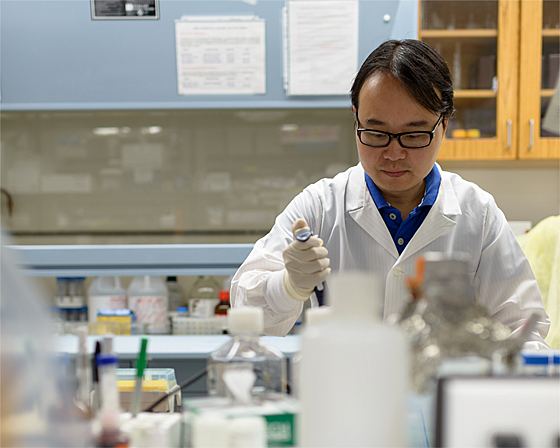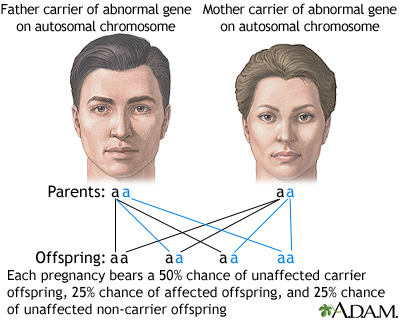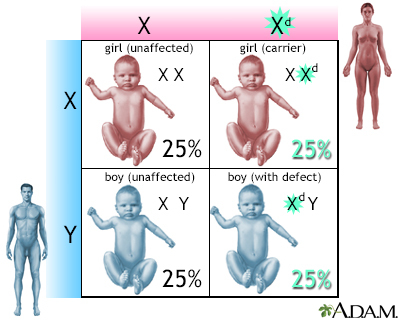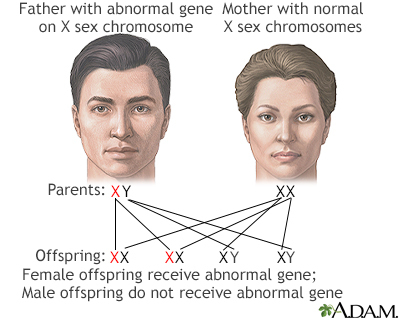Definition
Autosomal recessive is one of several ways that a trait, disorder, or disease can be passed down through families.
An autosomal recessive disorder means two copies of an abnormal gene must be present in order for the disease or trait to develop.
Alternative Names
Genetics - autosomal recessive; Inheritance - autosomal recessive
Information
Inheriting a specific disease, condition, or trait depends on the type of chromosome that is affected. The two types are autosomal chromosomes and sex chromosomes. It also depends on whether the trait is dominant or recessive.
A mutation in a gene on one of the first 22 nonsex chromosomes can lead to an autosomal disorder.
Genes come in pairs. One gene in each pair comes from the mother, and the other gene comes from the father. Recessive inheritance means both genes in a pair must be abnormal to cause disease. People with only one defective gene in the pair are called carriers. These people are most often not affected with the condition. However, they can pass the abnormal gene to their children.
CHANCES OF INHERITING A TRAIT
If you are born to parents who both carry the same autosomal recessive gene, you have a 25% (1 in 4) chance of inheriting the abnormal gene from both parents and developing the disease. You have a 50% (1 in 2) chance of inheriting one abnormal gene. This would make you a carrier.
In other words, for a child born to a couple who both carry the gene (but do not have signs of disease), the expected outcome for each pregnancy is:
- A 25% chance that the child is born with two normal genes (normal)
- A 50% chance that the child is born with one normal and one abnormal gene (carrier, without disease)
- A 25% chance that the child is born with two abnormal genes (at risk for the disease)
Note: These outcomes do not mean that the children will definitely be carriers or be severely affected.
References
Feero WG, Zazove P, Chen F. Clinical genomics. In: Rakel RE, Rakel DP, eds. Textbook of Family Medicine. 9th ed. Philadelphia, PA: Elsevier; 2016:chap 43.
Gregg AR, Kuller JA. Human genetics and patterns of inheritance. In: Resnik R, Lockwood CJ, Moore TR, Greene MF, Copel JA, Silver RM, eds. Creasy and Resnik's Maternal-Fetal Medicine: Principles and Practice. 8th ed. Philadelphia, PA: Elsevier; 2019:chap 1.
Jones KL, Jones MC, Campo M. Genetics, genetic counseling, and prevention. In: Jones KL, Jones MC, Campo MD, eds. Smith's Recognizable Patterns of Human Deformation. 8th ed. Philadelphia, PA: Elsevier; 2022:chap 2.
Korf BR. Principles of genetics. In: Goldman L, Schafer AI, eds. Goldman-Cecil Medicine. 26th ed. Philadelphia, PA: Elsevier; 2020:chap 35.




